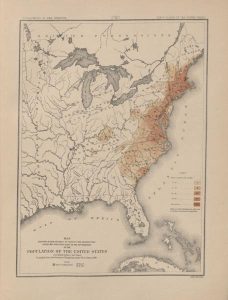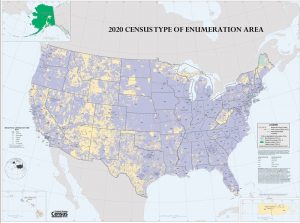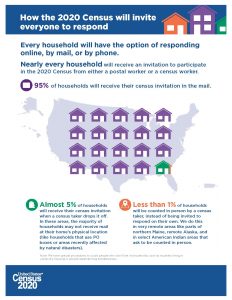The exhibit titled, “Help Make the Count: The U.S. Census Past and Present” can be viewed on the 2nd Floor of the Main Reading Room from 8/26 thru 11/11

Mark your calendars for April 1, 2020, Census Day! The census is a vital count that takes place every 10 years. The decennial census was mandated in 1790 by the U.S. Constitution, Article I, Section 2. [1] The first count included just six questions with a population totaling 3.9 million people, and the first enumerators were U.S. Marshals. The purpose of the count was the apportionment of the number of seats states have in the U.S. House of Representatives. [2]
In addition to apportionment the census counts demographic information including household size, income, race, and business ownership, which helps determine funding to support vital programs at the federal, state, and local levels.
Throughout the years the response questions have changed with the times to include manufacturing, agriculture, economic, and transportation related questions. [3] By 1870, the census started recording the names of all members of the household. In 1880, trained individuals replaced the U.S. Marshals as enumerators. By 1902, the U.S. Census Bureau became a permanent department and eventually moved to the U.S. Department of Commerce and Labor. The headquarters would eventually move to Suitland, Maryland in 1942. [4] The first count of Americans abroad from the armed forces and federal civilian personnel took place in 1950. In 2000, multiple responses to race appeared on the questionnaire. By 2010, a single questionnaire included 10 questions. [5]
Some populations are at risk for being undercounted. This occurs as a result from not being able to locate or persuade populations to take the census, “Traditionally undercounted populations include young children, American Indians and Alaska Natives, people experiencing homelessness, and people of color, among others.” [6]

Encouraging people to fill out the census is important and many groups have joined the Census Bureau to get the word out. The American Library Association (ALA) has been one of those groups. The ALA has been partnering with the U.S. Census Bureau to help with awareness and programming to prevent misinformation about the 2020 Census. In addition, libraries across the country are anticipating an increase in the use of computers and the internet.[7]
Confidentiality and security of the census is important. According to Title 13 of the U.S. Code, the law states the U.S. Census Bureau can not send personal identifiable information to law enforcement agencies. The information obtained from the census is only to be produced as statistics. [8]

This is the first census to encourage people to respond online. However, the option to submit a response by phone or mail is still available. The Census Bureau will send out a mailing that will include a unique ID code that people will use to submit their responses online.
The 2020 Census will include for the first time an option for people filling out the form to include same-sex relationships. [9] For the first time since the 1950 census there is a citizenship question that was added in March 2018 citing the enforcement of the Voting Rights Act. There is now a controversy surrounding the addition of a citizenship question because many believe by adding the question non-citizens will not respond to the census, which would affect apportionment and funding. The Supreme Court did rule that there was insufficient evidence for why the question should appear on the 2020 Census. [10] President Trump had vowed that he was going to continue to pursue adding the citizenship question to the census but has since decided not to. Instead he will obtain citizenship information through other means.
Other uses for the census records include historical research and genealogy. Past census records can include the names of family members, state or country of birth, year of immigration, street address, marriage status, occupation, and crops that were grown. The most current year available is 1940, there is a 72-year restriction on the records. The 1950 Census will be available in 2022. Online access is available for free at the National Archives facilities. Check with your local library to see if they provide access. [11]
[1] https://www.census.gov/history/pdf/cff4.pdf Retrieved 7/9/2019.
[2] https://www.census.gov/about/what/census-at-a-glance.html#history Retrieved 7/9/2019.
[3] https://www.census.gov/history/www/programs/. Retrieved 7/9/2019
[4] https://www.census.gov/history/www/census_then_now/ Retrieved 7/8/2019
[5] https://www.census.gov/history/img/timeline_census_history.bmp Retrieved 7/9/2019
[6]http://www.ala.org/advocacy/sites/ala.org.advocacy/files/content/govinfo/LibrariesGuide2020Census.pdf Retrieved 7/10/2019
[7]http://www.ala.org/advocacy/sites/ala.org.advocacy/files/content/govinfo/LibrariesGuide2020Census.pdf Retrieved 7/10/2019
[8]https://www.census.gov/library/fact-sheets/2019/dec/2020-confidentiality.html Retrieved 7/11/2019
[9]http://www.ala.org/advocacy/sites/ala.org.advocacy/files/content/govinfo/LibrariesGuide2020Census.pdf Retrieved 7/9/2010
[10] Michael Wines. (2019, June 25). Reopened Legal Challenge to Census Citizenship Question Throws Case Into Chaos. The New York Times. https://www.nytimes.com/2019/06/25/us/census-citizenship-question.html Retrieved June 28, 2019
[11] https://www.archives.gov/research/census Retrieved 7/11/2019
